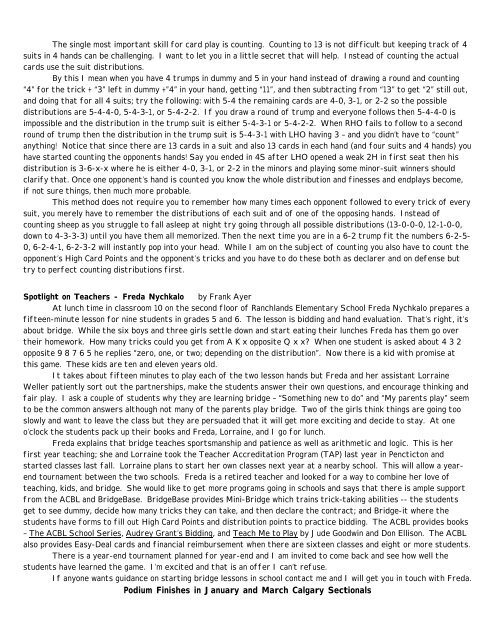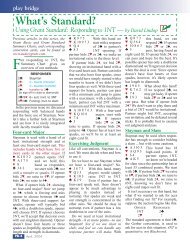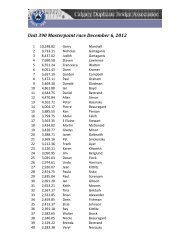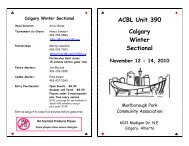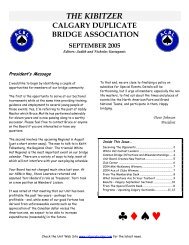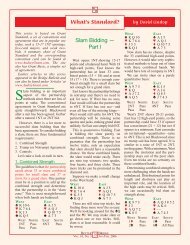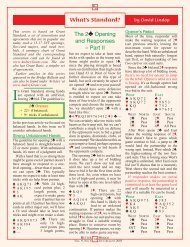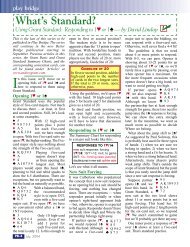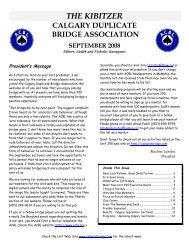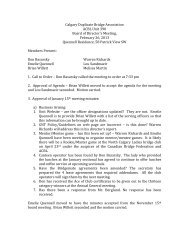2004-04 - Home of Calgary Duplicate Bridge Association
2004-04 - Home of Calgary Duplicate Bridge Association
2004-04 - Home of Calgary Duplicate Bridge Association
You also want an ePaper? Increase the reach of your titles
YUMPU automatically turns print PDFs into web optimized ePapers that Google loves.
The single most important skill for card play is counting. Counting to 13 is not difficult but keeping track <strong>of</strong> 4<br />
suits in 4 hands can be challenging. I want to let you in a little secret that will help. Instead <strong>of</strong> counting the actual<br />
cards use the suit distributions.<br />
By this I mean when you have 4 trumps in dummy and 5 in your hand instead <strong>of</strong> drawing a round and counting<br />
“4” for the trick + “3” left in dummy +”4” in your hand, getting “11”, and then subtracting from “13” to get “2” still out,<br />
and doing that for all 4 suits; try the following: with 5-4 the remaining cards are 4-0, 3-1, or 2-2 so the possible<br />
distributions are 5-4-4-0, 5-4-3-1, or 5-4-2-2. If you draw a round <strong>of</strong> trump and everyone follows then 5-4-4-0 is<br />
impossible and the distribution in the trump suit is either 5-4-3-1 or 5-4-2-2. When RHO fails to follow to a second<br />
round <strong>of</strong> trump then the distribution in the trump suit is 5-4-3-1 with LHO having 3 – and you didn’t have to “count”<br />
anything! Notice that since there are 13 cards in a suit and also 13 cards in each hand (and four suits and 4 hands) you<br />
have started counting the opponents hands! Say you ended in 4S after LHO opened a weak 2H in first seat then his<br />
distribution is 3-6-x-x where he is either 4-0, 3-1, or 2-2 in the minors and playing some minor-suit winners should<br />
clarify that. Once one opponent’s hand is counted you know the whole distribution and finesses and endplays become,<br />
if not sure things, then much more probable.<br />
This method does not require you to remember how many times each opponent followed to every trick <strong>of</strong> every<br />
suit, you merely have to remember the distributions <strong>of</strong> each suit and <strong>of</strong> one <strong>of</strong> the opposing hands. Instead <strong>of</strong><br />
counting sheep as you struggle to fall asleep at night try going through all possible distributions (13-0-0-0, 12-1-0-0,<br />
down to 4-3-3-3) until you have them all memorized. Then the next time you are in a 6-2 trump fit the numbers 6-2-5-<br />
0, 6-2-4-1, 6-2-3-2 will instantly pop into your head. While I am on the subject <strong>of</strong> counting you also have to count the<br />
opponent’s High Card Points and the opponent’s tricks and you have to do these both as declarer and on defense but<br />
try to perfect counting distributions first.<br />
Spotlight on Teachers - Freda Nychkalo by Frank Ayer<br />
At lunch time in classroom 10 on the second floor <strong>of</strong> Ranchlands Elementary School Freda Nychkalo prepares a<br />
fifteen-minute lesson for nine students in grades 5 and 6. The lesson is bidding and hand evaluation. That’s right, it’s<br />
about bridge. While the six boys and three girls settle down and start eating their lunches Freda has them go over<br />
their homework. How many tricks could you get from A K x opposite Q x x? When one student is asked about 4 3 2<br />
opposite 9 8 7 6 5 he replies “zero, one, or two; depending on the distribution”. Now there is a kid with promise at<br />
this game. These kids are ten and eleven years old.<br />
It takes about fifteen minutes to play each <strong>of</strong> the two lesson hands but Freda and her assistant Lorraine<br />
Weller patiently sort out the partnerships, make the students answer their own questions, and encourage thinking and<br />
fair play. I ask a couple <strong>of</strong> students why they are learning bridge – “Something new to do” and “My parents play” seem<br />
to be the common answers although not many <strong>of</strong> the parents play bridge. Two <strong>of</strong> the girls think things are going too<br />
slowly and want to leave the class but they are persuaded that it will get more exciting and decide to stay. At one<br />
o’clock the students pack up their books and Freda, Lorraine, and I go for lunch.<br />
Freda explains that bridge teaches sportsmanship and patience as well as arithmetic and logic. This is her<br />
first year teaching; she and Lorraine took the Teacher Accreditation Program (TAP) last year in Pencticton and<br />
started classes last fall. Lorraine plans to start her own classes next year at a nearby school. This will allow a yearend<br />
tournament between the two schools. Freda is a retired teacher and looked for a way to combine her love <strong>of</strong><br />
teaching, kids, and bridge. She would like to get more programs going in schools and says that there is ample support<br />
from the ACBL and <strong>Bridge</strong>Base. <strong>Bridge</strong>Base provides Mini-<strong>Bridge</strong> which trains trick-taking abilities -- the students<br />
get to see dummy, decide how many tricks they can take, and then declare the contract; and <strong>Bridge</strong>-it where the<br />
students have forms to fill out High Card Points and distribution points to practice bidding. The ACBL provides books<br />
– The ACBL School Series, Audrey Grant’s Bidding, and Teach Me to Play by Jude Goodwin and Don Ellison. The ACBL<br />
also provides Easy-Deal cards and financial reimbursement when there are sixteen classes and eight or more students.<br />
There is a year-end tournament planned for year-end and I am invited to come back and see how well the<br />
students have learned the game. I’m excited and that is an <strong>of</strong>fer I can’t refuse.<br />
If anyone wants guidance on starting bridge lessons in school contact me and I will get you in touch with Freda.<br />
Podium Finishes in January and March <strong>Calgary</strong> Sectionals


